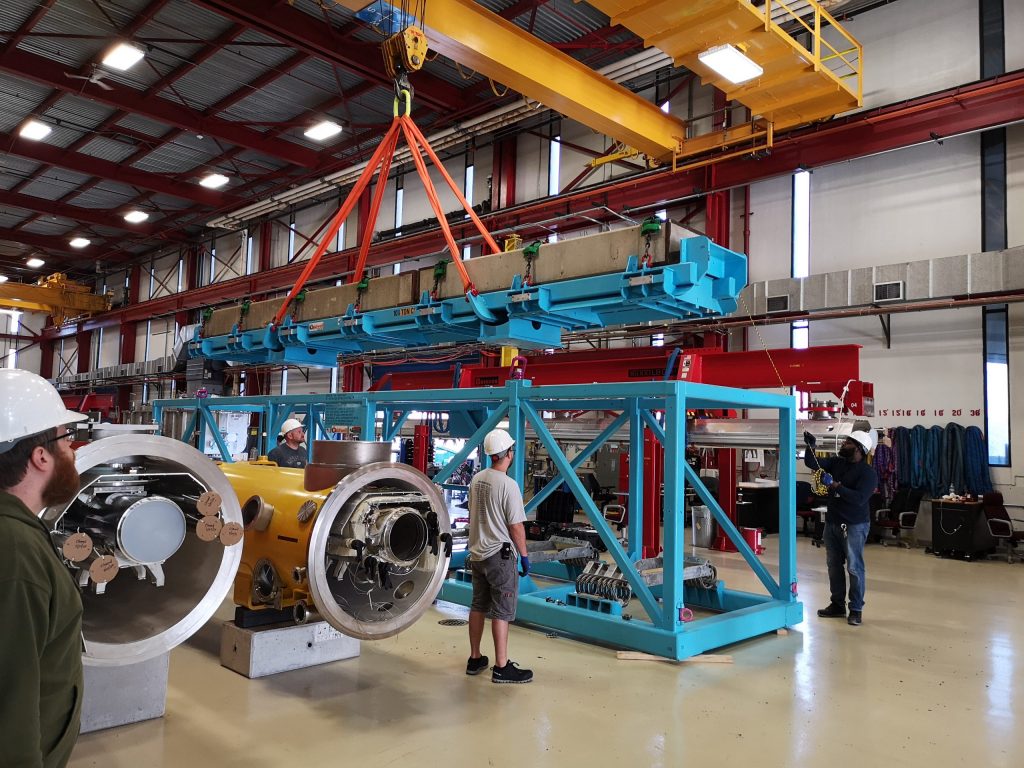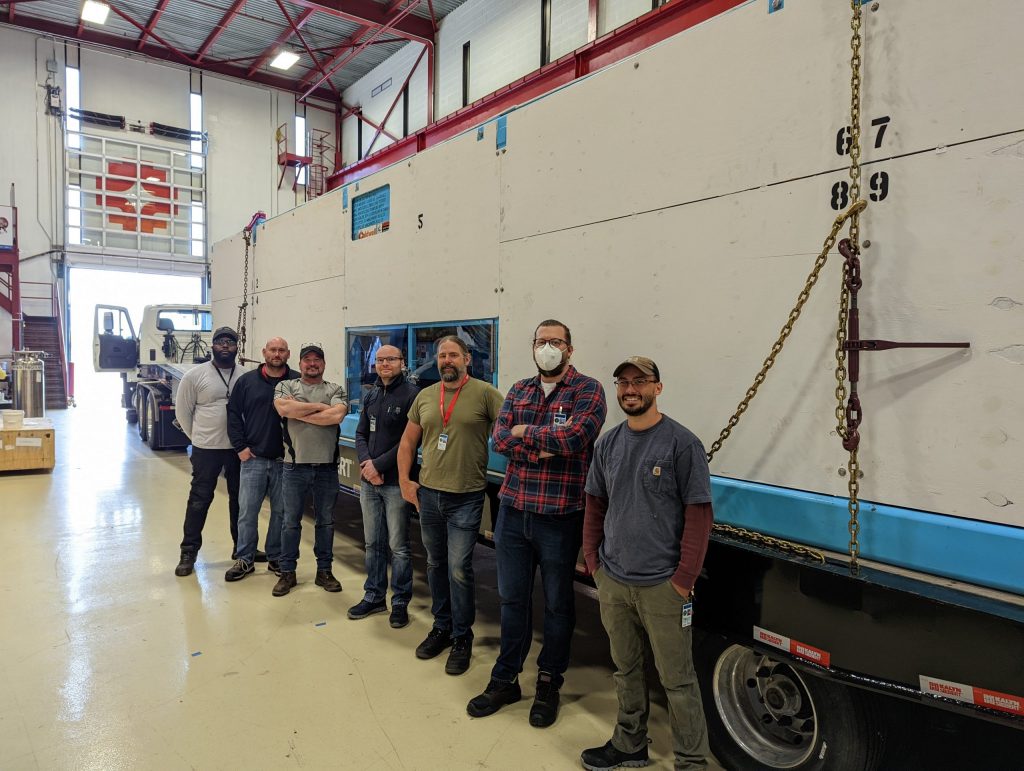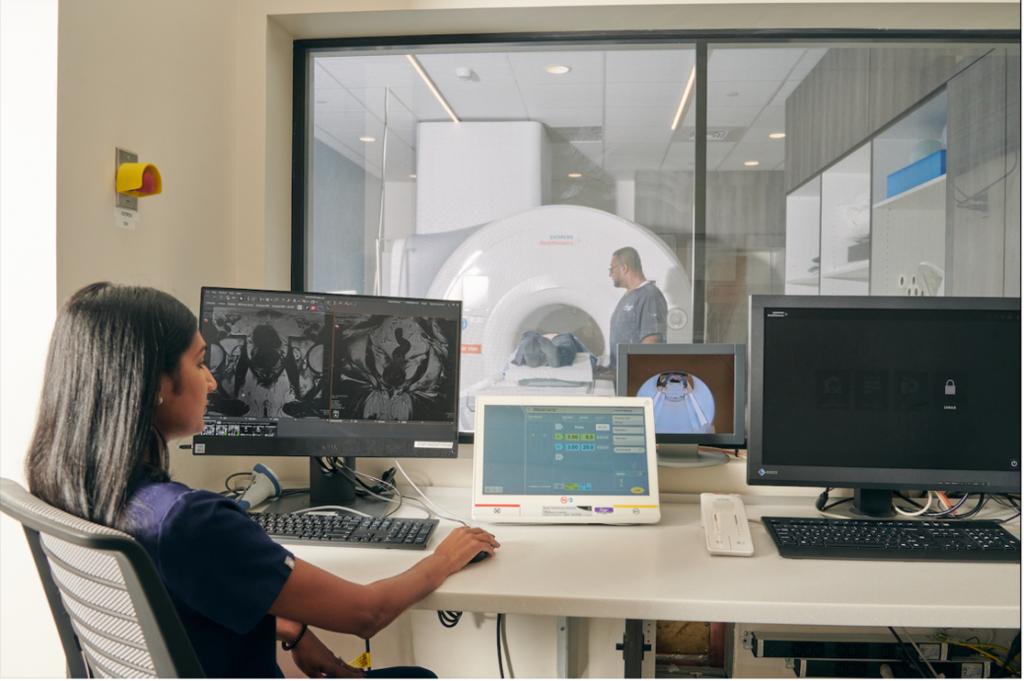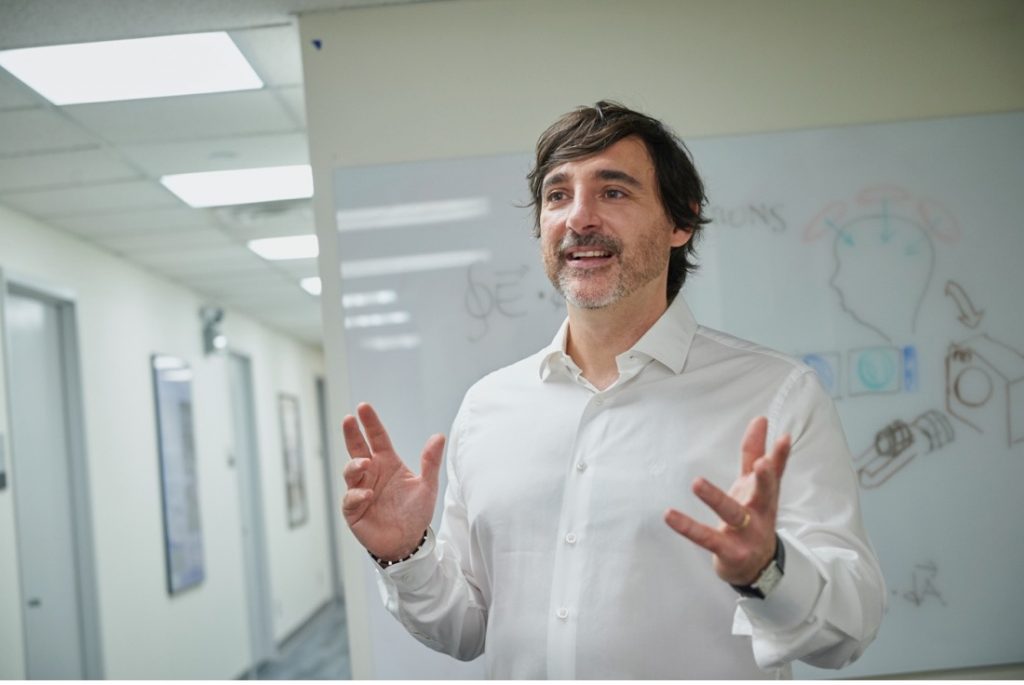Cryomodules are essential components for the U.S. Department of Energy’s Fermi National Accelerator Laboratory’s accelerator complex upgrade, known as the Proton Improvement Plan II, or PIP-II.
PIP-II features a brand-new, 800-million-electronvolt leading-edge superconducting radio-frequency linear accelerator, or linac for short, that will enable Fermilab to produce more than 1 megawatt of beam power, 60% higher than current capabilities. To achieve this groundbreaking feat, the linac will be made up of cryomodules, which are vessels containing niobium cavities.
The first particle accelerator on U.S. soil built with significant contributions from international partners, PIP-II will receive three assembled cryomodules from partners at the Science and Technology Facilities Council in the United Kingdom and nine assembled cryomodules from Commissariat à l’Énergie Atomique et aux Énergies Alternatives, or CEA, in France.
Safely transporting these delicate and expensive assembled components to Fermilab will be a major challenge for the PIP-II team. Based on a recent experience where a cryomodule for another experiment was damaged in transit, the team is taking extra precautions to ensure the safe transportation of PIP-II’s cryomodules, including extensive tests of the transportation system.

The concrete dummy load being lowered into the test frame at the Industrial Center Building. Photo: Mitchell Kane, STFC
The first step was to design, build and test a transportation frame that will hold and protect the cryomodules. While PIP-II collaborators at STFC—and later, CEA—will eventually design and build their own frame, a prototype of the STFC frame was built at Fermilab where it will be used to ship a dummy load and prototype cryomodules. This design and validation are a team effort between the three labs, with the results and lessons learned influencing the design of the final shipping frames that will transport the production cryomodules from STFC and CEA to Fermilab.
“The whole project is working as one to [achieve] one approach for transport,” said Jeremiah Holzbauer, a Fermilab scientist in the PIP-II Technical Integration Office. “We’re all learning through this first process together.”
Mitchell Kane, a mechanical project engineer at STFC, designed the test frame in close collaboration with Fermilab, who then hired a U.S. company to build the frame.
The most difficult part of the process, Kane said, was that there isn’t yet a finalized design for the cryomodule that the frame will eventually hold. “You have to have some flexibility in the design. With flexibility, there’s uncertainty,” said Kane.
The Fermilab team fabricated a dummy load to be a replica of the cryomodule—essentially, concrete blocks with the dimensions, weight and mounting points of the cryomodule. They then demonstrated the complex installation of the dummy load into the test frame and prepared it for transportation tests.
For now, the test frame assembly is an example of the successful collaboration of an international team—hopefully, one of many triumphs to come for PIP-II.
“We were able to actually have a pretty flawless first-time around of setting this thing up,” said Ryan Thiede, technical specialist for cryomodule assembly. “It turned out pretty well. Everything lined up. We had very few problems, and it seemed like everybody was pretty impressed with the first go-around of the setup.”
Kane visited Fermilab in late April to oversee the frame assembly and dummy load test. “Because of COVID and everything, I hadn’t seen anything physically for two-and-a-half years. So actually going there and seeing my design in person and it actually [going] together without any problems was probably the best [part of this experience],” he said.
On April 25, the test frame endured a three-hour highway road test to check the performance of the isolation system, which is designed to cushion the ride of the cryomodule. “It went extremely smoothly. The design is quite good,” said Holzbauer.
This summer, the test frame holding the dummy load will be shipped to the UK where STFC technicians will disassemble it, put it back together and ship it back to Fermilab. This process will also check the transport logistics, such as customs inspections and airplane loading.
“If that goes successfully, the transport system is verified,” said Holzbauer.

Part of the Fermilab PIP-II team that worked on the test frame assembly in front of the assembled test frame. Left to right: Amos Horton, Ryan Thiede, Jim Focht, Mitchell Kane (STFC), Adam Wixson, Robin Cubizolles (CEA), and Ronnie Lovstad. Photo: Jeremiah Holzbauer, Fermilab
Next, PIP-II will use the frame to ship a prototype cryomodule to the UK, which is currently planned for the end of this year. Once there, PIP-II partners at STFC will unload the prototype cryomodule and take it through instrumentation and vacuum checks before sending it back to Fermilab.
“Once it’s shipped back to us, we’ll test it again and make sure it really still performs as well as it did,” said Holzbauer. “That’s the ultimate proof that we can ship cryomodules. And that basically is the core demonstration [that] we can ship all of our cryomodules.”
Finally, in a few years’ time, the STFC will ship the production cryomodules in their own refined version of the shipping frame to Fermilab for the construction of PIP-II. Kane said they have already noted some small tweaks in the design that they’ll make to the UK frame.
Then, in 2025, it will be CEA’s turn to put their own transportation frame to use. Once production begins, the French collaborators plan to ship cryomodules to Fermilab at a pace of one per month.
Robin Cubizolles, an engineer at CEA and a PIP-II sub-project coordinator for cryomodules and transportation, observed the procedures for the assembly and design of this test frame and said he learned a lot that he will inform the CEA transportation system.
“I want to thank Fermilab for the good collaboration. [There is] a lot of transparency in every aspect,” said Cubizolles. “For me, it’s my first project with this kind of [collaborative working arrangement], and it’s really nice to see that.”
For now, the test frame assembly is an example of the successful collaboration of an international team—hopefully, one of many triumphs to come for PIP-II.
“Working between the technical team here like myself, the instrumentation people here and the partners both at CEA and STFC, I think we made a lot of very good design changes in the pre-planning stage,” said Holzbauer. “We got a lot of our procedures really in line, really vetted, and all the specifications were very clean. They helped us with vendor oversight. And so that all built up to today, when we all came together real smoothly, really clean, very safely, and it all went exactly like we wanted it.”
Fermi National Accelerator Laboratory is supported by the Office of Science of the U.S. Department of Energy. The Office of Science is the single largest supporter of basic research in the physical sciences in the United States and is working to address some of the most pressing challenges of our time. For more information, please visit science.energy.gov.
From magnetic resonance imaging machines to a state-of-the-art quantum computer in development, researchers are exploring potential applications of two superconducting technologies to revolutionize medical imaging. Researchers plan to explore a new method for analyzing MRI scans through a new partnership between the Superconducting Quantum Materials and Systems Center, hosted at the U.S. Department of Energy’s Fermi National Accelerator Laboratory, and New York University Langone Health. It marks the first SQMS Center partnership that would directly advance healthcare.
When doctors analyze MRI scans—one of the most common medical-imaging techniques used to create an image of organs and tissues within a patient’s body—they use their knowledge of the human body and experience in interpreting MRI images to diagnose illness or prescribe treatment to patients.
Medical imaging scientists are now on a quest to achieve quantitative MRI, or qMRI. This innovative process would involve computers working alongside physicians to help identify and characterize tissues to complement the doctors’ interpretation of the images.
Then add quantum computing to the equation.
When fully realized, quantum computers will offer a huge increase in computing power. The algorithms these next-generation computers will use to perform calculations could considerably improve qMRI and facilitate its translation into clinical practice. If accomplished, qMRI would give doctors a powerful tool to treat patients. Doctors would then have the capability to compare MRI scans in a quantitative fashion instead of just looking at MRI images. By relying on quantifiable parameters instead of inconsistencies in the MRI images’ contrast, medical professionals and researchers could use statistics and perform machine learning across MRI scans.
How an MRI machine works
Imagine: It’s a sunny day on Lake Michigan, and many sailboats are sitting in the water, facing random directions. Suddenly, a strong gust of wind blows across the lake, tacking their sails and orienting the boats in one direction. These boats are like protons, a particle found in the nuclei of atoms. Protons have a property called a magnetic moment, which means they act like tiny bar magnets with a magnetic field that points in a certain direction.
Using a powerful magnet, an MRI machine, like the strong gust of wind, aligns the magnetic moment of the protons in a patient’s body in the same direction. MRI technicians push the protons away from the magnetic field with radiofrequency pulses. When the protons’ magnetic moments reorient toward the MRI’s magnetic field, they release electromagnetic energy, which the machine detects and uses to create an image.
“We expect to demonstrate that quantum computing can lead to faster and more comprehensive approaches to extract relevant biophysical information from MRI to improve clinical diagnoses.”
– Riccardo Lattanzi, associate professor of radiology, NYU Grossman School of Medicine
Up to 60% of the human body is water, which is concentrated unevenly in bodily tissue, so MRI machines normally target the hydrogen protons in water molecules to make different tissues vary in brightness from one another, resulting in a detailed black-and-white image of the inside of a patient’s body.
“One technique for identifying biophysical properties of human tissue using MRI is known as magnetic resonance fingerprinting and is an active research area at NYU Langone,” said Riccardo Lattanzi, an associate professor of radiology at NYU Grossman School of Medicine and the principal investigator in this partnership. “In this method, MRI data are used as ‘fingerprints’ to home in on the underlying tissue properties that are ‘guilty’ for the observed MRI signal behavior.” Along with water content, other properties help create the contrast between bodily tissues in an MRI scan.
Quantum computing research for healthcare
Using data from the MRI machine and information held within the voxels, or 3D pixels of the MRI image, doctors will be able to measure these properties to evaluate and monitor a patient’s health across multiple scans. Quantum computing can make these measurements faster and can generate more accurate simulations of an MRI signal to uncover the underlying properties behind the MRI data fingerprints.
“Using standard methods to perform these simulations, scientists can only simulate simplified biophysical models, but quantum computing could enable calculations that account for chemical exchanges among many molecules. This opens the door to a more accurate assessment of the properties of the human body,” said Lattanzi.
The research collaboration between NYU Langone and SQMS is proposed as a pilot program, pairing two young researchers from each institution. These researchers would then develop algorithms used by future SQMS quantum computers to make accurate and rapid estimations of multiple tissue properties from MRI scans.
“In this pilot program, we want to explore the use of quantum algorithms to optimize quantitative MRI,” said Lattanzi. “We expect to demonstrate that quantum computing can lead to faster and more comprehensive approaches to extract relevant biophysical information from MRI to improve clinical diagnoses. Quantum computers are becoming an increasing reality, and we want to be ready to exploit their full potential.”
SQMS-host institution Fermilab leads cutting-edge research on superconductors, or materials that lose their electrical resistance when sufficiently cooled. This property makes them great for making superconducting radio frequency cavities to accelerate particles in particle accelerators, and now, for making a quantum computer.
Fermilab was selected to host one of the five DOE National Quantum Information Science Research Centers as part of the National Quantum Initiative Act to develop a quantum computer based on superconducting technology, due to its expertise in superconductors used for particle accelerators. NYU has received DOE Office of Science approval to become a member of the SQMS Center. The start of the collaboration is pending final approval of a formal agreement between NYU and Fermi Research Alliance, LLC.
“SQMS is making important advancements in superconducting-based quantum computing, including the development of a 3D-based quantum processor based on SRF cavities. Working with NYU Langone on the MRI application will have a great impact on medicine and society and will help our technology experts refine architectural details of our 3D-based SRF computers,” said Anna Grassellino, the director of SQMS. “We are excited to welcome NYU and Professor Lattanzi to SQMS. The knowledge Lattanzi brings to the collaboration is a powerful continuation on the use of superconducting technologies.”
Fermi National Accelerator Laboratory is supported by the Office of Science of the U.S. Department of Energy. The Office of Science is the single largest supporter of basic research in the physical sciences in the United States and is working to address some of the most pressing challenges of our time. For more information, please visit science.energy.gov.
The Superconducting Quantum Materials and Systems Center at Fermilab is supported by the DOE Office of Science.
The Superconducting Quantum Materials and Systems Center is one of the five U.S. Department of Energy National Quantum Information Science Research Centers. Led by Fermi National Accelerator Laboratory, SQMS is a collaboration of 23 partner institutions — national labs, academia and industry —working together to bring transformational advances in the field of quantum information science. The center leverages Fermilab’s expertise in building complex particle accelerators to engineer multiqubit quantum processor platforms based on state-of-the-art qubits and superconducting technologies. Working hand in hand with embedded industry partners, SQMS will build a quantum computer and new quantum sensors at Fermilab, which will open unprecedented computational opportunities. For more information, please visit sqms.fnal.gov.


